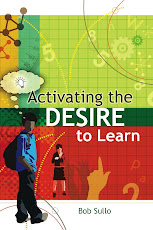After reading
“Standing Up To Bullying: Refusing To Be A Victim,” a reader from New Hampshire asked
me to discuss how I would handle a student who bullies another. (Note: Just as
I warned about the dangers of identifying kids as “victims” in “Standing Up To
Bullying,” I try to avoid calling kids “bullies.” So even though it’s faster
and easier to label a kid as a “bully,” I prefer to say “a kid who bullied
another.” It might seem like a subtle difference, but I think it dramatically
changes our perception and behavior.)
The following scene (or something like it) happened to me
more than once during my time as a middle school administrator. I return to my
office after supervising 200 fifth-grade students at lunch and my secretary
informs me that Jon is waiting for me. He has been sent to the office for
bullying other students. It’s not the first time. Apparently, Jon and was in
the boys’ bathroom when a fifth-grade boy entered. Jon told him the bathroom
was off limits unless he paid him. Scared beyond belief - Jon is a rather
imposing sixth-grader and the fifth-grade boy is both small for his age and
timid – the fifth grade boy left quickly and went to the nurse’s office where
he asked to use the facilities.
As I entered my office and saw Jon, chair tipped back and
just a trace of a smirk on his face, I immediately felt rage surging inside of
me. At that moment, I wanted to berate him. I wanted to humiliate him. I wanted
to punish him. A part of me even wanted to smack him. (Yeah, I’m a senior
faculty member of The William Glasser Association and consult all over the
world, but I haven’t fully eliminated anger from my behavioral repertoire.) As much as I genuinely like Jon, he
can be horribly mean and he had gone after a weak target. I was enraged. This
isn’t why I got into education.
Fortunately, I am well versed in internal control
psychology/choice theory. Even though nearly everybody I know would blindly
accept it if I were to say, “Jon makes me so angry!” I knew Jon doesn’t make me
anything. Like everyone else, he just behaves. Unfortunately for me (and lots
of others), he often behaves in hurtful, inappropriate ways. Today was no
exception. But the fact remains: Jon doesn’t make me angry or cause me to
lose it. He is responsible for his behavior; I am in control of mine, including
how I choose to deal with him at this moment.
So my first rule in dealing with a student who has bullied
another is this: remember my role and my goal. Forget the poorly behaving
student for a moment. Instead, let me focus on the following:
What’s my role in this situation?
Given my role, what do I want?
It has been my experience that when I remember to ask myself
these two questions, my anger dissipates and I can more easily access behaviors
that will help the offending child in front of me, allowing me to do my job
more effectively.
As a school administrator, my role included helping all kids behave responsibly, even those whose behavior
was horribly inappropriate. Berating Jon or humiliating him wouldn’t help him
grow, mature, and become more empathetic. Aggressively informing him of my
displeasure would only model a version of the bullying behavior I abhor. No, my
role required me to deal with Jon differently, even though my anger and
frustration with him was perfectly understandable.
And what did I want? Did I really want him to feel humiliated? No. I might have
harbored the false belief that humiliation would somehow magically lead Jon to
enlightenment, but what I really wanted was to help Jon develop a more
appropriate, empathetic repertoire of behaviors.
When I entered my office, my behavior was dominated by angry
emotion. In that state, there was literally no way I could do my job well. By
taking a moment to ask myself, “What is my role? Given my role, what is my
goal?” I gave myself a new way to behave, one that would allow me to deal more
effectively with a student who clearly needed adult help.
When we are faced with a child who has bullied another, we
understandably want to take immediate, decisive action. Because bullying is so
offensive to us, it’s easy to become a slave to our emotions in moments like
these. For that reason, I believe the essential first step in dealing with a
student who has bullied another is to calm ourselves by focusing on our role
and goal. Once we get our own emotions in check, we will be better able to
intervene effectively.
In an upcoming piece, I’ll discuss the kinds of things I
might specifically say to Jon and identify my two primary goals when working
with him.
***
As always, if you enjoyed this and found it useful, please
send the link to your friends. Thanks.
Bob Sullo
PO Box 1336
Sandwich, MA 02563
For information about books by Bob Sullo and to schedule a
keynote, workshop, or series for your school, agency, or parent group visit
www.internalmotivation.net






No comments:
Post a Comment